Speech Financial Stability: Review and Response
I'd like to thank CPA Australia for the invitation to speak to you today. As you may know, we recently released our twice-yearly Financial Stability Review. Most of what I have to say today draws heavily from that document. I would like to cover the main themes we have been focusing on, as described in the Review, before concluding with a couple of points of particular relevance to the accounting profession.
It's now more than three years since the turmoil first started in overseas interbank markets. And it's just over two years since Lehman Brothers failed. Conditions in the global financial system started to recover last year, and continued to do so over the past six months. But global financial markets remain prone to bouts of uncertainty. We saw an example of that in April and May, when concerns about Greek government finances spilled over into bank funding markets.
The latest data suggest the financial strength of Australian banks is continuing to improve. The domestic non-financial sectors also seem to be in a fairly sound state. Both households and businesses seem to have become a bit more cautious: that is probably a good thing, in that it might buttress their resilience to any future shocks that could come along. In short, Australia has come through the global disruptions of recent years in reasonably good shape. But the lessons of the crisis are still being absorbed, and in the policy community there is still much work to be done.
The Global Scene
The initial convulsion of 2007 and 2008 might seem to be over, but there's no doubt that the after-effects remain. In the boom phase of any cycle, investors pay little mind to the risks they run. All the talk is optimistic; all the expectations are of asset prices rising seemingly forever. The shocks that do occur are shrugged off.
But after the crisis has occurred, it is as if people can think only of risk, of what could go wrong. So it has been in the recent period. Before the crisis, markets were little perturbed by many events that, in other circumstances, might have triggered a panic. A hedge fund might fail; a small country's exchange rate might drop suddenly; or some US mortgage companies might start to collapse. All these things happened in 2006. Yet risk spreads stayed low, and the structured finance production machine kept chugging on (Graph 1).
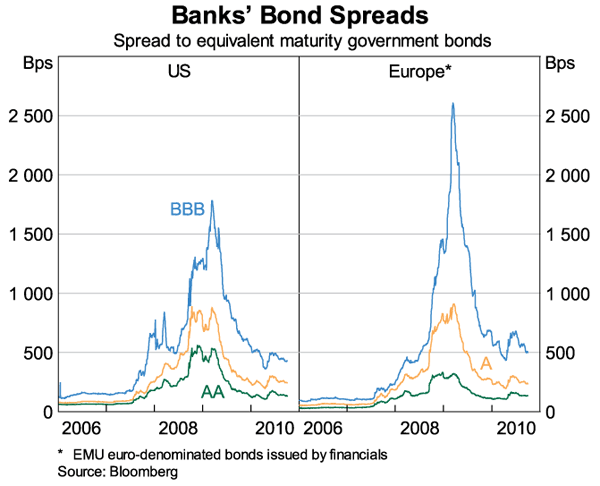
But since Lehman Brothers failed in September 2008, along with distress and collapse at other firms, risk aversion has increased. Markets seem more skittish. Smaller bouts of turbulence broke out, as concerns moved first to eastern Europe, then to Dubai. So when attention turned to countries like Greece, we saw that in the current, risk-averse, environment, a weak economy and fiscal position would no longer be ignored.
Greece was hardly involved in the original crisis of 2007 and 2008. Greek banks' exposure to poor-quality US housing-related assets was essentially zero. They were not major counterparties of the global financial firms that failed or became distressed, such as Bear Stearns or Lehman Brothers. Like any banking system, though, Greek banks are highly exposed to their domestic sovereign – both directly via bond holdings and funding spreads, and indirectly via the economy. Once concerns about Greece's fiscal position flared, it was not surprising that its banks were also affected. Loan losses in a weak economy only exacerbated those fears. Bank share prices fell (Graph 2).
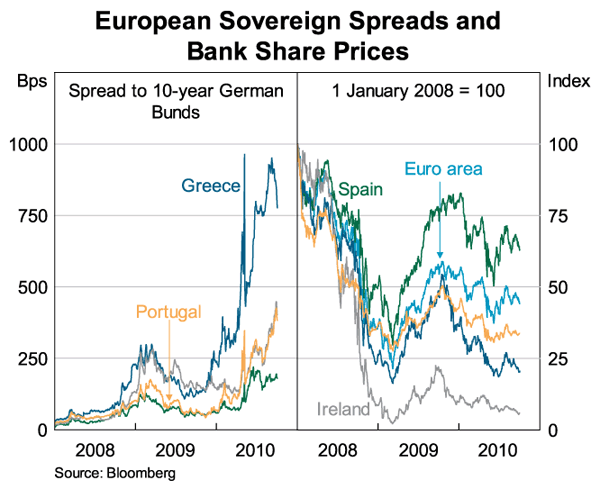
Then investors started worrying about the exposures of banks in other countries to Greece's government and banks. Other countries with weakened fiscal positions started to face scrutiny. Euro area countries faced a double burden in this situation. Unlike countries with their own currency, it is harder for them to get a boost to growth from a depreciating exchange rate, because they share a currency with many of their most important trading partners.
More recently, these concerns seem to have eased off somewhat. The joint European/IMF rescue package and the public stress testing of banks have both helped assuage some uncertainties. But markets remain concerned about Greece and countries such as Ireland. We can see this in risk spreads in sovereign debt markets, as well as in banks' share prices.
Looking at the global financial system more broadly, the picture is one of tentative improvement. Major banking systems have returned to profitability, which is helping them to rebuild the capital they need. In large part, this is because bad loan charges are now falling, as the economy improves (Graph 3). There are, however, large differences across countries, and across different types of bank in the same country.
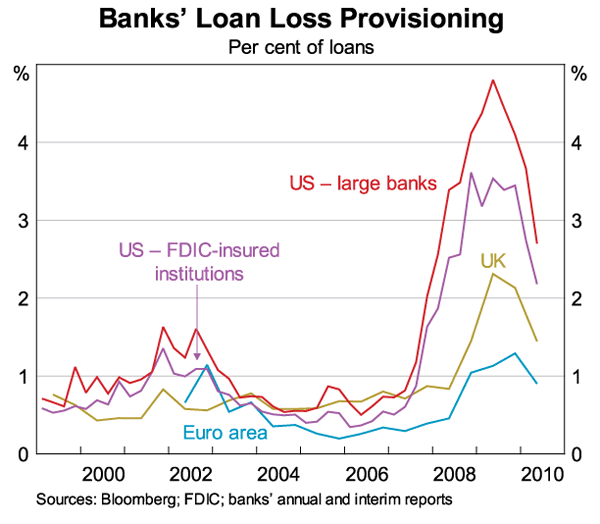
The Australian Financial System
In contrast to the banking systems in the United States or Europe, the Australian banking system has come through the last few years quite well. Banks and other deposit-taking institutions in Australia remained profitable in aggregate throughout the period. The sector remains well capitalised. And their bad and doubtful debt charges have started to turn down, especially at the major banks. The upshot is that return on shareholders' equity for both the major and smaller Australian banks dipped, but not very far in the scheme of things (Graph 4). And for both groups of banks, profitability has already started recovering.
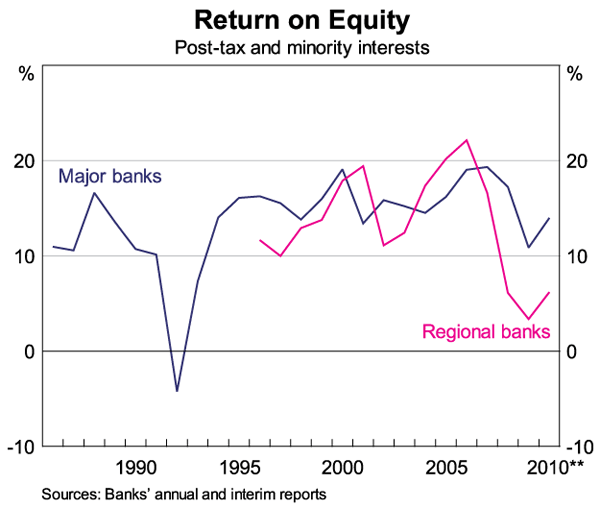
The quality of banks' assets did not deteriorate as much as in the last downturn in the early 1990s. The stock of their domestic assets that are considered impaired or otherwise non-performing is still drifting up in dollar terms. But there are signs it might be nearing a peak. As a share of all loans on their domestic books, non-performing assets seem to be stabilising (Graph 5).
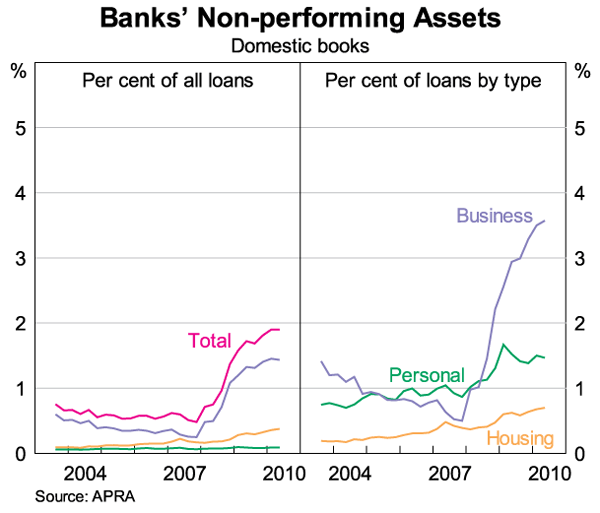
Part of the reason why this ratio has stabilised relates to the composition of banks' balance sheets. Compared with the early 1990s, a much smaller fraction of their domestic balance sheets is comprised of business lending, which is riskier in general. It also tends to deteriorate faster in an economic downturn. Housing lending has become more important to lenders over the past 20 years. The trend continued more recently, as housing lending expanded while business credit contracted.
In passing, I would note that Australian banks have almost no exposure to Greece or the other smaller euro area countries.
Over the past couple of years, Australian banks took a number of actions to buttress their liquidity and funding positions. They now rely less on short-term wholesale funding, and more on funding sources that are considered more stable. Among these is deposit funding. Banks and other deposit-takers have increased deposit interest rates relative to market rates, making deposits more attractive to savers. In fact, growth in deposits has actually outpaced that in credit over the past couple of years (Graph 6).
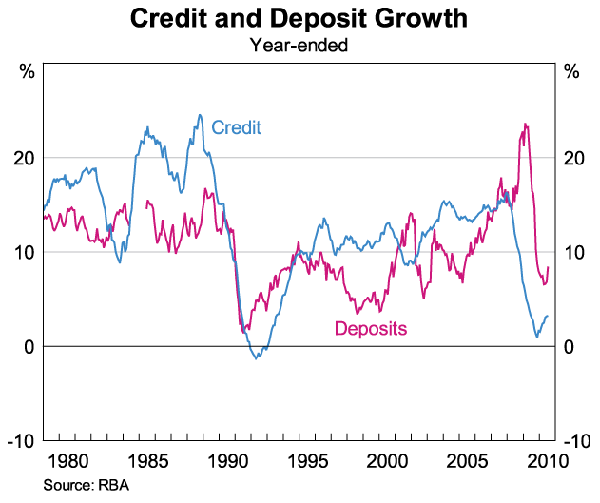
The Links to the Non-financial Sectors
Policymakers' concerns about financial stability stem, in the end, from the effects that the financial system can have on the real economy. We care about financial crises because of the economic and human costs they entail, not because of any direct concern for the financial firms themselves.
Policymakers must also be mindful of the feedback from the real economy to the financial sector. If the non-financial sectors are resilient to shocks, the financial system will not face as large losses from loans gone bad in a downturn. So we pay a lot of attention to the financial situations of the household and business sectors. We examine their balance sheets in detail. And we focus on lending standards, that is, the terms on which they are borrowing. These are hard to measure, but it is vital to track them. If either households or businesses were to overstretch themselves, they would become vulnerable to any macroeconomic or financial setback.
Our reading of recent data is that the Australian household and business sectors have, in aggregate, entered a phase of expansion. But they seem to be showing more financial caution than they did prior to the crisis. Although wage incomes and profits were quite soft during late 2008 and 2009, the effects of monetary and fiscal policy stimulus largely cushioned this. As the effects of policy wane, we are now seeing some hand-off back to employment income and profit growth.
At the same time, the housing market has probably cooled somewhat. Growth in dwelling prices has tapered off in recent months, especially in more expensive suburbs. Housing credit growth has slowed. New lending to first-home buyers reverted to closer to its historical share of loan approvals after the additional government grants expired (Graph 7). The difference has not so far been made up by other types of buyers. In particular, loans to property investor households have not surged the way they did during the more buoyant, rather speculative period in the early 2000s.
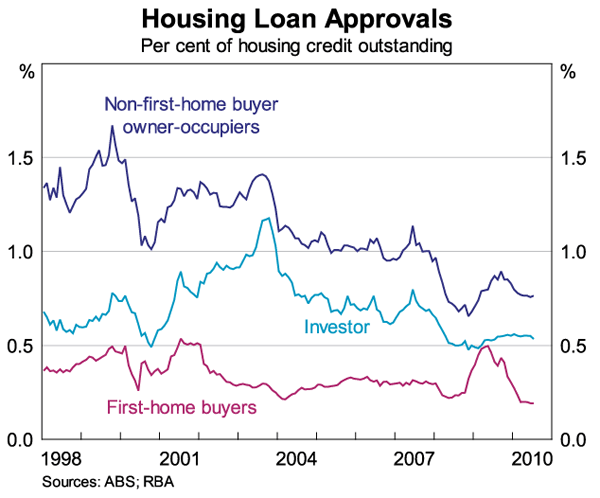
Businesses have entered the current upturn with stronger balance sheets in aggregate than they had at the peak of the global credit boom. Profitability has recovered to more normal levels. The outlook for mining company profits is particularly strong, for obvious reasons. But even before this turnaround, many firms had been using their internal funds to strengthen their finances, often to replace debt funding that had become more expensive and less available. Gearing ratios for listed firms have declined considerably as a result, especially for those firms and industries that were most leveraged before (Graph 8).
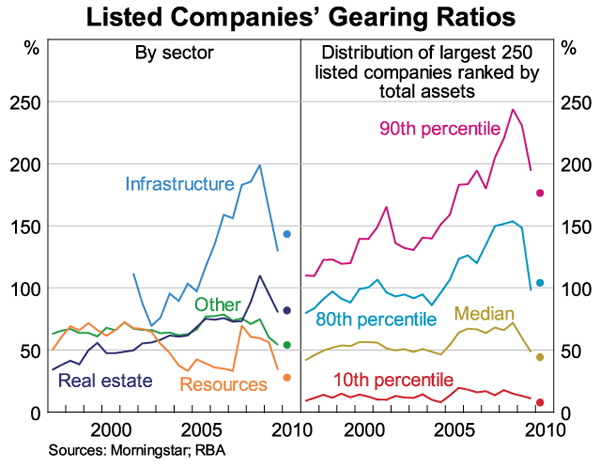
The Policy Response
The crisis and its aftermath hold many lessons for policymakers. The international system for regulation of banks needed to be improved. So did the way it had been implemented in some countries. The crisis showed that many banks around the world needed more capital. And they needed better-quality capital that could absorb losses while the bank was still a going concern.
The community of international regulators have been hard at work developing a new capital standard to meet this need. Recently the Basel Committee on Banking Supervision agreed on new capital requirements for banks. Previously, banks were required to hold a minimum amount of capital equal to 8 per cent of assets weighted by their riskiness. They also had to hold at least 4 per cent of risk-weighted assets in higher-quality so-called ‘Tier 1’ capital. There was no explicit standard for common equity – the most loss-absorbing kind of capital. But depending on how national supervisors interpreted the word ‘predominant’, banks could hold as little as 2 per cent of risk-weighted assets in that form of capital.
The new Basel standards set a new minimum for common equity of 4½ per cent of risk-weighted assets, and 6 per cent for Tier 1 (Table 1). They also involve a new ‘conservation buffer’ of 2½ per cent of common equity. Banks are likely to meet this buffer in normal times. Otherwise they will be subject to limits on their dividends and bonus payments. Including the buffer, the new standards imply that banks will hold at least 7 per cent of common equity, up from as little as 2 per cent. At 8½ per cent, the Tier 1 capital requirement including the buffer will be more than double the previous minimum.
| Common equity | Tier 1 capital | Total capital | |
|---|---|---|---|
| Minimum | 4.5 | 6.0 | 8.0 |
| Conservation buffer | 2.5 | ||
| Minimum plus conservation buffer | 7.0 | 8.5 | 10.5 |
| Counter-cyclical buffer range(a) | 0 to 2.5 | ||
|
(a) Common equity or other fully loss-absorbing capital Source: GHOS |
|||
There are also other changes involved in these reforms. Some instruments that used to count as capital will be excluded under the new standard; these will have to be replaced. Certain intangible and other assets will not be treated as having value, so they will have to be deducted from capital. And a range of other assets, including those most affected by the crisis, will have higher risk weights applied to them. So a 7 per cent capital ratio under the old system won't equal 7 per cent under the new system. How different the number could be will vary across banks and countries. The difference is probably smaller for Australian banks than some other places.
As you may have read, we expect that the Australian banks would already meet these requirements, or so nearly that they could do so quite easily. This is partly because APRA already required them to deduct many of the things that are newly required to be deducted under the Basel standards. Australian banks also don't tend to have large trading books, holding assets of the kinds that are to have higher risk weights under the new system. But for some banks in other countries, the task of reaching the new minimum, plus the buffer, is quite large.
The Basel reforms to capital are an important element in the international policy response to the crisis. But I would not want to give the impression that this was the only thing that needed to be done. Focusing only on capital would be like saying that all we needed to do to stop people being injured in car crashes was to ensure they all had big enough airbags. But bigger airbags are not enough. We also need safer driving, diligent policing and better roads.
For safer driving, we need to look to the people behind the wheel. As my colleague Guy Debelle recently pointed out, in the lead-up to the crisis, financial institutions had been seriously underestimating the risks they were running.[1] Since the crisis, they are being more cautious. But it's a hard way to learn the lesson. And eventually memories will fade and the reckless driving will start again. Of course sometimes people are minded to drive more carefully if they think they might be booked. So we also need to encourage better driving with diligent policing.
For diligent policing, read prudential supervision. Prudential regulation is only one part of the framework for ensuring the safety of the financial system. Supervision – how the rules are enforced – is arguably even more important. The Australian prudential regulator, APRA, has long taken a relatively conservative line compared to their counterparts in some other countries. They have enforced somewhat tighter rules in some areas than the Basel Accord required. But they have also placed a lot of emphasis on supervision. The importance of good supervision recently received strong international support.[2] We don't want banks to think that they are so well capitalised that it doesn't matter how much risk they take, or what kinds. There needs to be some limits to the total amount of risk-taking in the system. That is where supervision fits in.
For better roads, read financial infrastructure. There is a huge amount of work going on at both national and international levels to improve the infrastructure of financial markets, particularly for derivative securities traded over the counter, not on exchanges.
Another way of getting better roads is to have clearer signs and lane markings. Banks need to know where they are, and regulators and investors need to be confident that they know too. I am, of course, referring to the importance of robust and reliable accounting standards. One of the things that went wrong in the crisis was that confidence in structured financial securities collapsed. Mortgage-backed securities and collateralised debt obligations (CDOs) were among those most affected. Some of these securities never really traded in liquid markets. Their values were supposedly marked-to-market, but some of those prices were ‘guesstimates’ at best. Investors didn't know how much these securities were worth. And they panicked because they didn't know which banks held them and were therefore facing large unrealised losses. That uncertainty was a large part of the reason why distress in one relatively small market in a single country – the US sub-prime mortgage market – spread to other markets until it snowballed into a full-scale global banking crisis.
As this audience would know – almost certainly better than I do – there have been a number of important and welcome changes to international accounting standards of late. Several more are still out for consultation. I would like to point out two today. The first relates to how complex securities are valued. In short, it does not make sense to mark-to-market when the market doesn't really exist. The second relates more to the traditional lending business of banks. New rules for recognising impairments will allow banks to accumulate loan-loss provisions before explicit signs of impairment on those loans are observed. Accounting standards serve the needs of many different stakeholders, and I am conscious that there are diverse views about this change. From a financial stability perspective, at least, this change is welcome, because it encourages banks to provision for future loan losses better. Perhaps more importantly, it might reduce the incentives they face to make risky loans that seem profitable in a boom, but only because it was a boom.
So as you can see, even though Australia was relatively less touched by the crisis, there is still plenty to do. And as the economic expansion unfolds, we will need to be alert for signs that excessive risk-taking has emerged once again.
Thank you.
Endnotes
Debelle, G ‘On Risk and Uncertainty’, Address to Risk Australia 2010 conference, Sydney, 31 August 2010. [1]
See Viñals J et al (2010) ‘The Making of Good Supervision: Learning to Say “No”’, IMF Staff Position Note SPN/10/08. [2]
